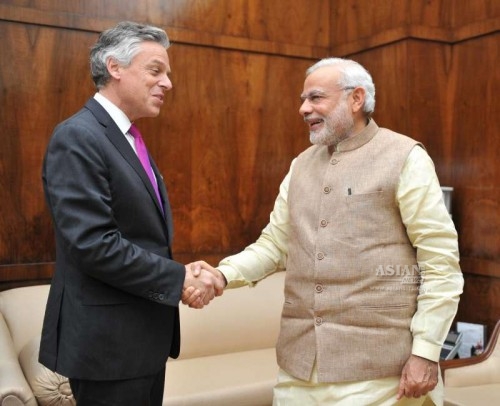
By C. Uday Bhaskar
The three island-nation trip that took Prime Minister Modi to Seychelles, Mauritius and Sri Lanka in mid-March may well mark the beginning of India’s long-overdue maritime awakening. For a nation so richly endowed with a distinctive maritime geography, the paradox has been the tenacious indifference, often veering towards inexcusable sea-blindness, that has characterised Delhi’s policy orientation as regards the Indian Ocean.
However, the very fact that Modi embarked upon such a trip to three strategically important island states in the Indian Ocean which have been long neglected by way of a summit visit reflects a political determination that has the potential to become the beginning of the end of this self-inflicted strategic myopia.
In Mauritius, Modi handed over an Indian built offshore patrol vessel (OPV) to that country’s Coast Guard and this marks the first such export of a naval ship designed and built in India. Christened the MCGS Barracuda, the 1,350 tonne ship, valued at $50 million was commissioned by Modi on March 12 and his speech at this ceremony could well be described as the most lucid and comprehensive articulation of India’s resurrected maritime vision for the Indian Ocean Region (IOR).
Highlighting the centrality of a cooperative strategy to manage the vast water body of the Indian Ocean and the role of the smaller island nations, Modi drew attention to the strategic significance of the IOR and noted: “The Indian Ocean is critical to the future of the world. This Ocean bears two-thirds of the world’s oil shipments, one-third of its bulk cargo and half of its container traffic. Over three-fourths of its traffic goes to other regions of the world.”
This overview is familiar to the professionals but what is instructive is the manner in which Modi invoked rich symbolism related to the national flag and endorsed the need for India to embark upon a Blue Revolution. In the course of his remarks at Port Louis, Modi observed: “To me the blue chakra or wheel in India’s national flag represents the potential of Blue Revolution or the Ocean Economy. That is how central the ocean economy is to us.” The speech writers in the prime minister’s stable warrant praise for the manner in which form and substance have been leavened.
India has witnessed two seminal revolutions that transformed the profile of the nation and the well-being of its people – namely the Green Revolution that began in 1963 and transformed India from a ‘basket-case’ to becoming self-sufficient in food production; and later the White Revolution (also referred to as Operation Flood) of 1970 that made India into the world’s largest milk producer.
The Blue Revolution endorsed by Modi, if realized in its entirety, has the potential to transform India in similar manner and both the normative vision and the policy clarity are laden with deep import. Asserting that the “Indian Ocean Region is at the top of our policy priorities”, Modi added that the regional vision “is rooted in advancing cooperation in our region; and, to use our capabilities for the benefit of all in our common maritime home.”
Five elements prioritize the core security interests of India and yet combine the collective well-being of the IOR. Inter alia, they include: “We will do everything to safeguard our mainland and islands and defend our interests; we will deepen our economic and security cooperation with our friends in the region, especially our maritime neighbours and island states; collective action and cooperation will best advance peace and security in our maritime region; we also seek a more integrated and cooperative future in the region that enhances the prospects for sustainable development for all; and those who live in this region have the primary responsibility for peace, stability and prosperity in the Indian Ocean but we recognize that there are other nations around the world, with strong interests and stakes in the region.”
This maritime pentagon provides the foundation for the Modi vision of the IOR and is in many ways a logical extension of the modest but relatively still-born ‘sagar mala’ (ocean garland ) enunciated by former Prime Minister Atal Bihari Vajpayee in August 2003 that sought to revitalize the moribund Indian ports sector and inland connectivity.
India’s comprehensive national power that includes the economic and trade sinews and the military component can be robustly advanced by sustained investment in the maritime sector. This is a well-trodden path taken by many major powers before India and the symbiotic relationship between ship-building, port efficacy and inland cum coastal connectivity lie at the core of such national endeavor.
China, which is the most recent of the major powers to focus on the maritime sector, offers many policy cues for India. One of the first priorities is to review and rationalize the myriad ministries and departments that have sectoral and insular responsibility in managing India’s maritime assets.
This is a subject worthy of immediate cabinet and legislative attention and Modi would be well-advised to fast-track the implementation of the Blue Revolution. Furthermore, the coastal states need to become committed stakeholders in this national endeavor and this in turn will strengthen the federal character of the Indian polity – an often stated Modi objective.
The Indian Ocean is not India’s ocean alone but the Modi vision is laudable: “We seek a future for the Indian Ocean that lives up to the name of SAGAR – Security and Growth for All in the Region.”
Acronyms are addictive but the challenge now is to walk the talk and convert rich rhetoric into tangible reality.